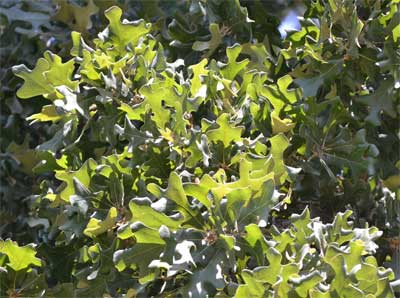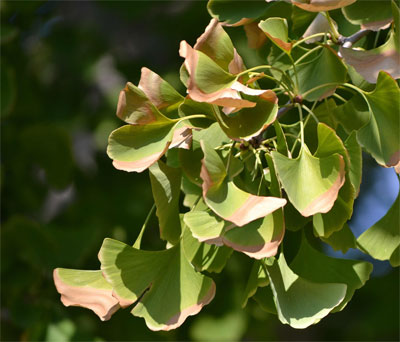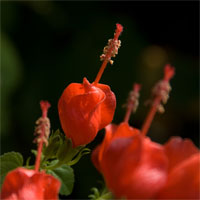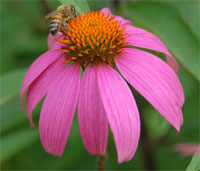Texas Tree Tips – March, 2012

Post oak (Quercus stella). Photo courtesy of Steve Houser.
Watering Trees
Knowing how to work within water restrictions and minimize their impact on your trees requires more than a simple formula or explanation. Given the variance in soil types, and the various types of plants as well as designs in our landscapes, proper watering and maintenance can require advice from the professionals, or research of our own. A little of both is ideal.
With or without water restrictions, the basic idea is to water deeply and thoroughly, saturating the soil, almost to the point of run-off. Then, let the soil dry before watering again. The top couple of inches should be dry to the touch. If you have clay soil, let it begin to crack at the surface before you water again. If you’re in doubt, dig into the top inch of soil and check it out. Don’t water if rain is in the immediate weather forecast. Allowing the soil to dry near the surface encourages tree roots to grow deeper, adding to the tree’s drought tolerance. Deep root systems also reduce the tree’s likelihood of leaning or falling over.
When conditions require severe watering restrictions, the objective of watering is to keep plants alive — not to promote healthy growth rates. Larger native and adapted trees do not need irrigation unless rainfall is below normal. As an example, mature post oaks (Quercus stella) may need supplemental water only a few times during the summer months while drought conditions exist, and not at all during normal conditions. However, ginkgo (Ginkgo biloba) may need irrigation several times a month during drought conditions.

Ginkgo (Ginkgo biloba). Photo courtesy of Steve Houser.
The frequency of watering for any species of plant can also vary according to the cultural conditions on a given site. Sites with a clay-based soil may hold water better than sand-based soils. Once normal rainfall returns, there is no need to water larger native or adapted trees unless health is a problem.

Beautyberry. Photo by Neil Sperry.

Turk’s cap. Photo by Neil Sperry.

Purple coneflower. Photo by Neil Sperry.
In fact, mature trees are often overwatered if moisture-loving plants are planted under their canopies. Trees prefer compatible companion plants. For our native trees, that means using shade-tolerant, low-water-use plants such as American beautyberry, Mexican buckeye, red buckeye, Turk’s cap, plumbago, blue mistflower, lantana, salvia greggii, Mexican petunia, and coneflower — all of which are quite attractive.
Trees also prefer a 1- to 2-inch bed of native mulch under the limbs to hold rainfall, conserve soil moisture, reduce evaporation, and lower the soil temperature. However, do not apply mulch near or on the trunk and larger roots.
Watering with automatic irrigation system
The best way to ensure proper watering of your landscape with an automatic irrigation system, as well as adhere to water restrictions, is to rely on professionals. A licensed irrigator can audit your system to reduce waste and offer advice on system updates that can save water. An audit will help you update the system and provide uniform water distribution using the most efficient methods. Next, meet with a professional landscaper and an arborist to determine the frequency and duration of watering, based on your plants’ needs, as well as the parameters of the water restrictions. The frequency will need to be adjusted according to rainfall events and changes in water restrictions, all requiring diligence on the part of the homeowner.
Watering by hand and manual sprinklers
Hand watering typically puts the right amount of water where it is needed, but it requires your time. Soak the soil completely from the base of the tree out to the ends of the foliage (or drip line). A water hose can be left at a slow drip and moved around. Just don`t forget about moving it or your manual sprinkler. Flooding a neighbor’s yard may not be taken kindly.
Watering with soaker hoses or drip irrigation
Soaker hoses and drip irrigation are very efficient at saving water. (Soaker hoses typically have a short life.) During a severe drought, neither method is perfect at dispersing the water evenly in the soil. Soil moisture is lacking at deeper levels in the soil, and soaker hoses or drip irrigation may not move water outward through the soil as efficiently as they would in normal conditions. For this reason, avoid adding mulch over the top of a soaker hose that is lying on the bare soil or over a drip irrigation head on the soil. Placing the soaker hose or drip irrigation head at one-half the depth of the mulch (from the soil to the top of the mulch) encourages more even water dispersal, as well as water conservation.
Watering recently planted trees
Without rainfall, most newly planted trees require watering two times a week during the late spring and summer months. Watering frequency should be curtailed as rainfall totals increase and fall approaches.
Water is the essential element of all life, and it should be treated as such.
About the author: Steve Houser is a Dallas native with more than 30 years of experience as a consulting arborist and tree climber. He is the president of Arborilogical Services Inc., “The Experts Your Trees Deserve.” www.arborilogical.com.

Watch for important information from the Texas Water Smart Coalition in upcoming months. Neil Sperry’s GARDENS Magazine and e-gardens newsletter are proud to be a part of that effort. Water conservation is critical to all Texans, and each of us must do our part. Watering trees carefully is certainly a part of that good and prudent use of our water resources.

